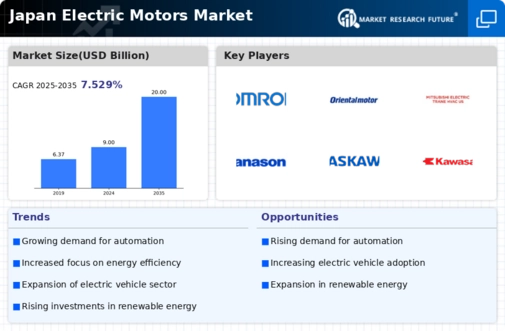Rising Demand for Automation
The electric motors market in Japan experiences a notable surge in demand for automation across various industries. This trend is primarily driven by the need for increased efficiency and productivity in manufacturing processes. As companies strive to enhance operational performance, the adoption of electric motors in automated systems becomes essential. In 2025, the market for electric motors in automation applications is projected to grow by approximately 15%, reflecting a shift towards more sophisticated manufacturing techniques. The electric motors market is thus positioned to benefit from this growing inclination towards automation, as businesses invest in advanced technologies to streamline operations and reduce labor costs.
Expansion of Renewable Energy Sources
The transition towards renewable energy sources in Japan is a critical driver for the electric motors market. As the country aims to increase its reliance on solar, wind, and hydroelectric power, the demand for electric motors in these sectors is expected to rise. Electric motors play a vital role in the operation of renewable energy systems, such as wind turbines and solar panel tracking systems. The electric motors market is projected to witness a growth of approximately 10% as more renewable energy projects are initiated. This shift not only supports Japan's energy goals but also enhances the overall market landscape for electric motors.
Technological Advancements in Motor Design
Technological advancements in motor design are reshaping the electric motors market in Japan. Innovations such as improved materials, enhanced efficiency, and compact designs are driving the development of next-generation electric motors. These advancements enable manufacturers to produce motors that are lighter, more efficient, and capable of operating under diverse conditions. The electric motors market is likely to benefit from these innovations, as they cater to the evolving needs of various sectors, including automotive, industrial, and consumer electronics. The anticipated growth in this segment could reach around 8% as companies adopt these advanced motor technologies.
Government Initiatives for Sustainable Development
Japan's government actively promotes sustainable development, which significantly influences the electric motors market. Initiatives aimed at reducing carbon emissions and enhancing energy efficiency are gaining traction. The government has set ambitious targets to cut greenhouse gas emissions by 46% by 2030, which necessitates the adoption of energy-efficient electric motors. This regulatory environment encourages manufacturers to innovate and develop eco-friendly motor technologies. The electric motors market is likely to see increased investments in research and development, as companies align their products with governmental sustainability goals, potentially leading to a market growth rate of around 12% in the coming years.
Increased Investment in Electric Mobility Solutions
The electric motors market in Japan is significantly influenced by the rising investment in electric mobility solutions. As the automotive industry shifts towards electric vehicles (EVs), the demand for high-performance electric motors is expected to escalate. Major automotive manufacturers are committing substantial resources to develop electric drivetrains, which rely heavily on advanced electric motors. The electric motors market is projected to grow by approximately 20% as the adoption of EVs accelerates. This trend not only reflects a broader commitment to sustainable transportation but also positions the electric motors market as a key player in the future of mobility.























Leave a Comment